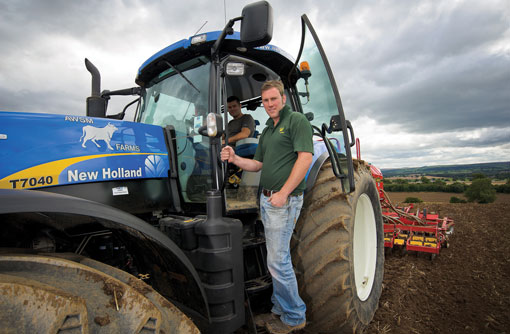A better year allows plans to be made at AWSM Farming

Total harvest income at AWSM Farming will be fractionally better than budget. With little spent on drying costs, it was also a much easier and less costly harvest than in 2012. I feel we will have had a better year than last year when the final figures come through, then we can look at next steps, says owner Adam Metcalfe. Harvest was completed as usual with the help of several extra pairs of hands the temporary crew included the good, the bad and the terrible, says Mr Metcalfe and while there were no major problems, the season was not without its moments. Apprentice Adam Close has settled in well and was also part of the harvest crew on grain-carting duties. He has also been working with stock and tanker driving for the contracting business. Risk assessments for his tasks were carried out by Askham Bryan College. Like many growers, Mr Metcalfe initially held well back from selling any 2013 grain but is now very relieved to have sold all his wheat at an average price of 168.39/t to the usual customers, Frontier Agriculture and GrainCo. Oats grown as a one-off following the battle to get crops in for the 2013 harvest have been dropped from the rotation and the more familiar wheat, barley, rape rotation is back in place for 2014. Aside from the seasonal routines at AWSM, work will shortly start on the rainwater harvesting scheme, which will collect water from 3,750sq m of grain store roof area, with underground pipes feeding a 100,000-litre, below-ground plastic tank. At 1.14/cu m which the business pays for water, this has the potential to save 3,000 a year. A 30% grant has been approved through the RDPE Farming and Forestry Improvement Scheme for the 32,623 system and an extension of the deadline until the end of November has been agreed for the work to start. This investment was originally planned for last spring but, with cash very tight, Mr Metcalfe has deferred the spending until absolutely necessary. Next March will see the three-year leases end on three New Holland tractors, so he is considering how to replace these. Most likely is a set of three further three-year leases but the brand has not been decided. Mr Metcalfe is gearing up for an expansion in the spreading side of the contracting business as AD plants in the area come on stream. We have had quite a lot of interest from farmers in taking the digestate its a good product. At a rate of 15t/ha, the digestate should deliver 60kg of available nitrogen/ha, 76kg of phosphate and 110kg of potash and at roughly a 30% discount to the cost of bagged fertilisers. In nutrition terms its worth 8.54/t and we will be offering it at 5.98/t including spreading, says Mr Metcalfe. Uptake should be quicker than with conventional fertilisers and it will contain organic matter and trace elements too. However, digestate spreading is not without its complications and costs the environmental permitting paperwork requires good organisation and understanding. Where the material being applied to land is considered waste, permits known as deployments are needed at 760 for every 50ha spread. Mr Metcalfe would have been tempted to build his own AD plant but distance from a grid connection means this is a non-starter. However, he is planning a woodchip-fired biomass boiler through the Renewable Heat Incentive (RHI). The installation is planned before tarriff changes next March and will provide heat and power to local houses, the new farm office and workshop. With a lot of hard work on the part of environmental manager Louis Smith, the business is also working its way to achieving ISO 14001 accreditation. This is a recognised standard of environmental management that is particularly important for the waste side of the business and especially when looking to work with local authorities. It demonstrates the business uses an effective environmental management system and can provide assurance that environmental impact is being measured and improved. The structure of this business is complicated, with farming, contracting and waste elements, so it is important to have a solid day-to-day accounting routine. Some costs are shared between the different elements of the business so invoice amounts must be correctly apportioned and allocated. The complexity of the business also means that good communication with staff is essential there is owned land, tenanted land and several contract farming agreements as well as extensive contract work. Environmental schemes are a good example all operators must know about areas such as the 10ha of headlands which are to be left unharvested as part of the farms HLS agreement, as well as other parcels such as in-field lapwing plots, which must remain untreated. Both Mr Metcalfe and shepherd Graeme Wood have studied closely the 27-page EID sheep movement document, but were unclear about the exact meaning of some of this guidance. Again the complexity of the business with many different holding numbers presents a challenge. Every field was walked on a recent inspection of the farms Entry Level Scheme, which did not find any problems. Turning to CAP reform, with a large proportion of the business being contract farming, this is not so much of an issue for AWSM as for many others although compulsory greening elements, the three-crop requirement, could cause some practical and financial challenges. Harvest budgeted yield and outcome yield Crop Budget yield t/ha (acres) Actual yields t/ha (acres) Wheat 6.8 (2.75) 6.8 (2.74) Spring barley 4.9 (2.0) 5.0 (2.04) Winter barley 6.8 (2.75) 6.33 (2.56) Oilseed rape 3.2 (1.3) 3.0 (1.2) HEAR oilseed rape 3.2 (1.3) 3.7 (1.49) Spring oats 4.9 (2.0) 4.6 (1.84)
Next steps at AWSM
FARM FACTS: AWSM Farming, Hutton Magna, North Yorkshire
